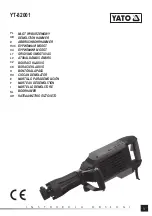
VII. Processing and Storing Oil
Because the oil that is pressed out contains liquid from the raw
materials, the coloration of the oil will vary with the material used.
Peanut oil, walnut oil, and white sesame oil should appear a light
ivory. Black sesame oil will appear a light black. The colors of these
liquids will change depending on heat used during the drying out
process.
Once the oil is pressed from the raw material, store it at room
temperature overnight. The oil will naturally separate from the
other liquids without any filtering. The longer you store your mixture
at room temperature, the more complete the separation will be.
Once the oil is completely separated, you can bottle it and store
in your fridge, or keep it at room temperature. It is recommended
to use oils within 60 days of pressing.
Note:
The oil quality will be a reflection of the raw materials used.
Raw materials of low quality, aged, or kept in poor conditions, will
yield cloudier and lower quality oil. Therefore it is important to use
the best quality raw materials possible for oil pressing.
The heating temperature and control of the raw materials is a vital
part of the process. Microwave ovens are the preferred method
for heating. Items should be heated until soft to the bite. A 3 min-
ute heating is a good start time, though times will vary dependent
on the raw material used and the age of the material.
Raw materials should never be put into the machine when wet.
This will lead to damage of the machine, and inefficacy of oil ex
-
traction. Similarly, overly dry materials will not produce oil, instead
a dry powder. If this happens, stop pressing immediately.
To avoid these occurrences, start with small quantities of raw ma-
terials, to make sure the heating time you use is appropriate.
Additionally, limit the quantities of raw materials used. Using an ex-
cessive amount will allow some to cool while in the hopper, which
will lead to malfunction.
VIII. Preparing the Raw Materials
Содержание USSOILP1
Страница 20: ......






































